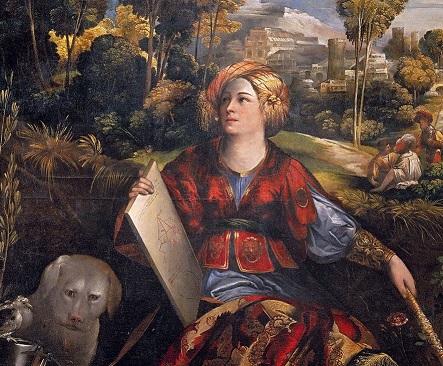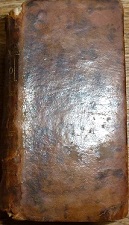The World of Ariosto
Oxford, Taylor Institution
16-17 June 2016
2016 marks the 500th anniversary of the publication of Ariosto’s Orlando furioso, one of the most precious gems of the Italian Renaissance, a chivalric romance brimming with dazzling feats of arms and seductive love stories whose graceful irony and underlying seriousness have never ceased to enthral and intrigue readers and critics alike. Since the beginning of this anniversary year there has been a number of celebratory events in different parts of the world, with more being planned for the coming months. Oxford had no desire to overlook this centenary and on 16-17 June 2016 the Taylor Institution hosted a two-day international conference entitled ‘500 Years of Orlando Furioso’. (Link here to the conference programme: Oxford Ariosto Conference.) Two bibliographic displays, devoted to Ariosto and his world, were also on show. One group of works was exhibited in the Taylor Institution Library’s Voltaire Room; another group could be seen at the Weston Library.
These displays were designed to visually highlight key moments in both the publishing history of the poem and also the history of its reception and interpretation in Italy and Europe, with a focus on the sixteenth and early seventeenth centuries. They were conceived as visual counterparts to the Oxford Ariosto conference, whose main themes were tradition, reception, and interpretation. At the Taylorian, the items were drawn from the Italian collections of the Taylor Institution Library: though not as large as that of the Bodleian Library, its early printed book collection includes a number of valuable editions of Renaissance chivalric classics as well as works of literary criticism.
- ORLANDO FVRIOSO / DI M. LODOVICO /ARIOSTO / CON LA GIVNTA DI CINQUE CANTI / D’VN NVOVO LIBRO DEL MEDESIMO, ORNATO DI VARIE FIGVRE […], Venice, Gabriel Giolito de’ Ferrari, 1555
- ORLANDO FVRIOSO / DI M. LODOVICO ARIOSTO / TVTTO RICORRETTO, / ET DI NVOVE FIGVRE / ADORNATO. / CON le Annotationi, gli Auuertimenti, & le Dichiarationi di Giro-/lamo Ruscelli, / La Vita dell’Autore, descritta dal Signor Giouan Battista Pigna […], Venice, Vincenzo Valgrisi, 1562
Ariosto’s fame began to spread far and wide soon after the publication of the 1532 Furioso. It was reprinted 16 times by 1540, and for the next decades every year saw the publication of at least one edition, mostly in Venice, one of the centres of the European printing industry in the sixteenth century. Particular highlights of the display were copies of sixteenth-century Venetian editions of Orlando furioso. The 1555 Gabriele Giolito edition, the 1562 Vincenzo Valgrisi Furioso and the 1584 Francesco de’ Franceschi Furioso are decorated with beautiful woodcuts (copper engravings in the case of the latter edition), and visitors could compare different illustrations to the first canto of the poem.
![ORLANDO / FVRIOSO / DI M. / LODOVICO ARIOSTO / Nuouamente / adornato di Figure di Rame / da Girolamo Porro […], Venice, Francesco de Franceschi Senese, 1584](http://blogs.bodleian.ox.ac.uk/taylorian/wp-content/uploads/sites/155/2016/08/2016-08-bbb-Francheschi1584-Resized.jpg)
ORLANDO / FVRIOSO / DI M. / LODOVICO ARIOSTO / Nuouamente / adornato di Figure di Rame / da Girolamo Porro […], Venice, Francesco de Franceschi Senese, 1584
- ORLANDO / FVRIOSO / DI M. LODOVICO / A R I O S T O / Tutto ricoretto, & di nuove figure adornato , / Con li Diʃcorʃi di Girolamo Ruʃcel/li nel principio de’ Canti; / Et di nuovo aggiunti i cinque Canti, / del medeʃimo Autore […], Venice, Vincenzo Valgrisi, 1570
Robert McNulty’s edition of John Harington’s 1591 translation of the poem, as well as the Spanish (Jerónimo de Urrea, 1553) and French (François de Rosset, 1625) translations, gave visitors an idea of Ariosto’s success outside Italy. His renown in his native land was further reflected in the selection of sixteenth-century scholarly works devoted to Orlando furioso, ranging from Simon Fórnari’s Spositione (1549) to Giuseppe Malatesta’s Della nuova poesia, o vero delle difese del Furioso (1589).
Other items included chivalric poems by Luca Pulci (a 1572 copy of Ciriffo calvaneo) and Matteo Maria Boiardo’s Orlando innamorato, together with Nicolò degli Agostini’s sequel in Domenico Imberti’s 1602 edition), Ariosto’s comedy Cassaria (the 1560 Giolito edition) and Boiardo’s translation of Herodotus (Giovan Antonio di Nicolini di Sabbio, 1533).
![CIRIFFO CALVANEO / DI LVCA PVLCI / Gentilhuomo Fiorentino. / Con la Giostra del Magnifico Lorenzo / DE MEDICI […], Florence, Stamperia de’ Giunti, 1572](http://blogs.bodleian.ox.ac.uk/taylorian/wp-content/uploads/sites/155/2016/08/2016-08-CiriffoCalvaneo1572-Resized.jpg)
CIRIFFO CALVANEO / DI LVCA PVLCI / Gentilhuomo Fiorentino. / Con la Giostra del Magnifico Lorenzo / DE MEDICI […], Florence, Stamperia de’ Giunti, 1572

ORLANDO / INNAMORATO / DEL / S. MATTEO MARIA / BOIARDO, CONTE / DI SCANDIANO. / INSIEME COI TRE LIBRI DI M. NICOLO / de gli Agostini, già riformati per M. / Lodouico Domenichi […], Venice, Domenico Imberti, 1602.
The Taylor Institution Library display was held in conjunction with another, shown at the recently renovated Weston Library. The latter featured two illuminated manuscripts of fifteenth-century chivalric poems, a manuscript of Matteo Maria Boiardo’s collection of lyric poetry, and a copy of the 1532 definitive edition of Orlando furioso. The displays were accompanied by an illustrated catalogue (here split into two parts, for easier consultation) produced by Dr Maria Pavlova with the help of Anna Wawrzonkowska, a second-year student in Italian and Linguistics.
LINK to the catalogue: 2016-06-Ariosto-Weston and Taylorian Part 1-Taylorian
LINK to the catalogue: 2016-06-Ariosto-Weston and Taylorian Part 2-Weston
Maria Pavlova
Joanna Randall MacIver Junior Research Fellow, St Hugh’s College
Faculty of Medieval and Modern Languages
DISCORSO / SOPRA IL PRINCIPIO / DI TVTTI I CANTI / D’ORLANDO FVRIOSO. / DELLA S. LAVRA TERRACINA, / detta nell’Academia de gl’incogniti, Febea […], Venice, Gabriel Giolito de’ Ferrari, 1565
Further reading
Ludovico Ariosto. Orlando furioso secondo la princeps del 1516, ed. Marco Dorigatti (Firenze: Olschki, 2006)
Orlando Lina Bolzoni and Loreta Lucchetti. L’Orlando furioso nello specchio delle immagini (Roma: Istituto della Enciclopedia italiana, [2014?])
Lina Bolzoni, et al. L’Orlando Furioso e la sua traduzione in immagini: http://www.orlandofurioso.org/
Sir John Harington, trans. Ludovico Ariosto’s ‘Orlando furioso’, ed. Robert McNulty (Oxford: Clarendon Press, 1972)
Neil Harris. Bibliografia dell’“Orlando innamorato” (Modena: Panini, 1988)
Daniel Javitch. Proclaiming a Classic: the Canonization of “Orlando Furioso” (Princeton: Princeton University Press, 1991)
Ita MacCarthy. Women and the making of poetry in Ariosto’s Orlando furioso (Leicester: Troubador, 2007)
Marco Villoresi. La letteratura cavalleresca: dai cicli medievali all’Ariosto (Roma: Carocci, 2000)






![DISCORSO / SOPRA IL PRINCIPIO / DI TVTTI I CANTI / D’ORLANDO FVRIOSO. / DELLA S. LAVRA TERRACINA, / detta nell’Academia de gl’incogniti, Febea […], Venice, Gabriel Giolito de’ Ferrari, 1565](http://blogs.bodleian.ox.ac.uk/taylorian/wp-content/uploads/sites/155/2016/08/2016-08-LauraTerracina1565-Resized.jpg)

















